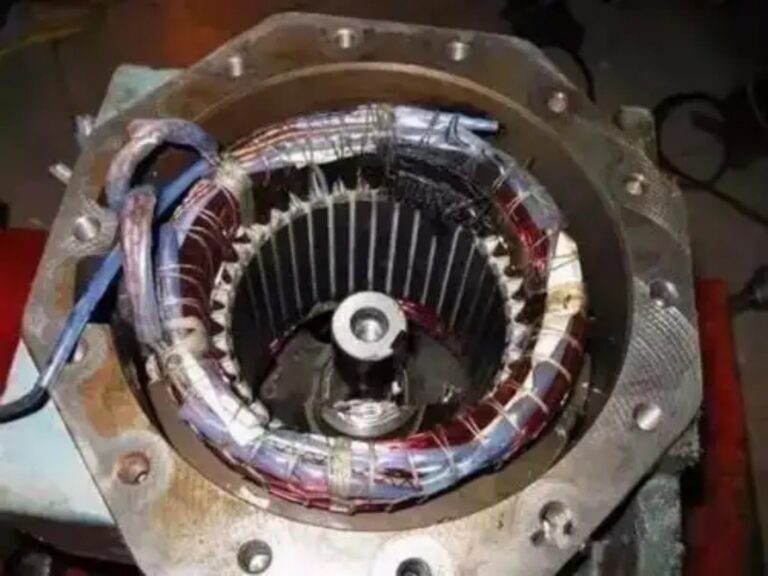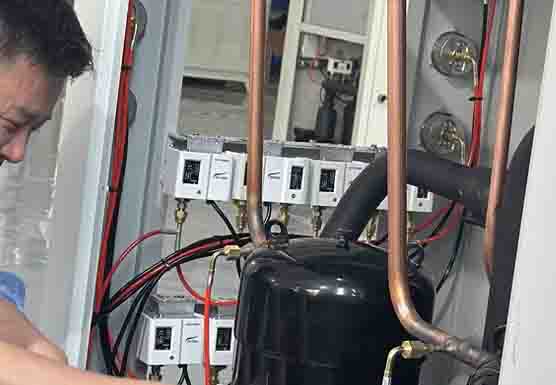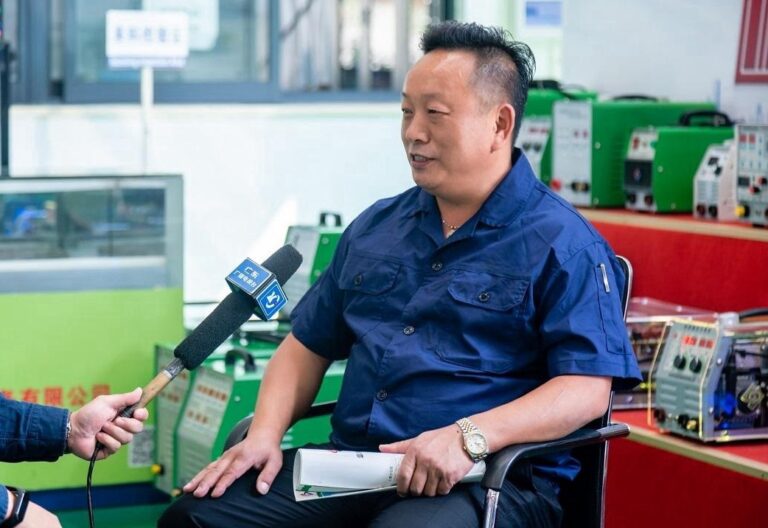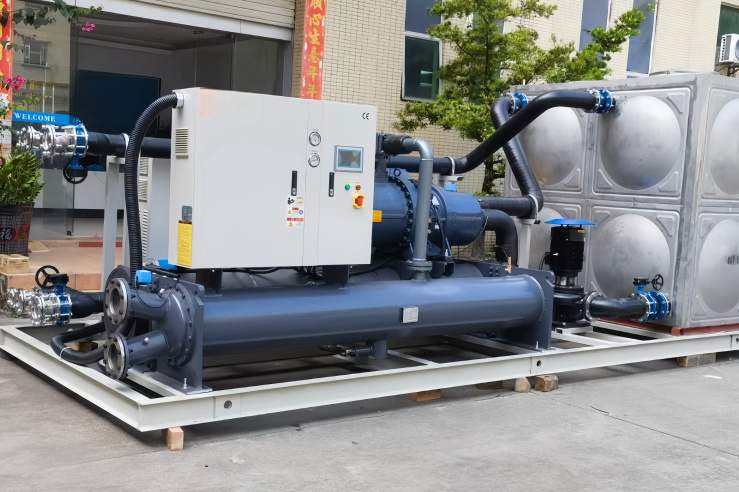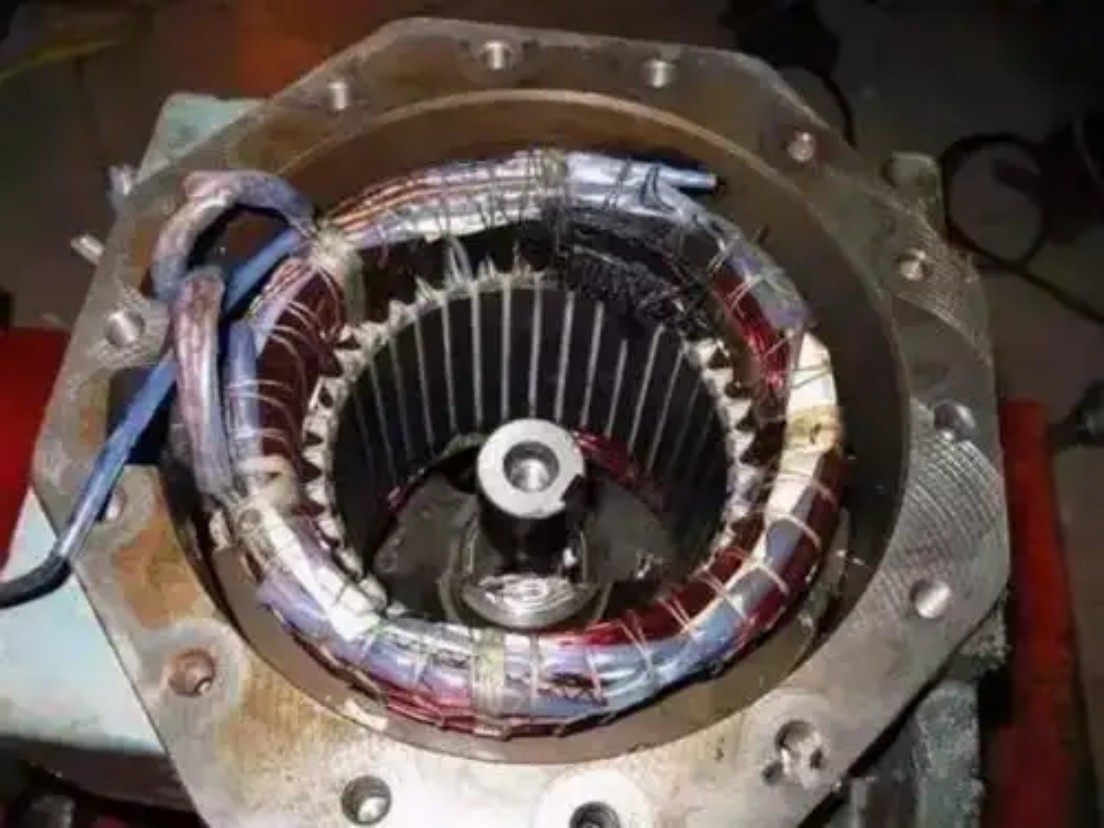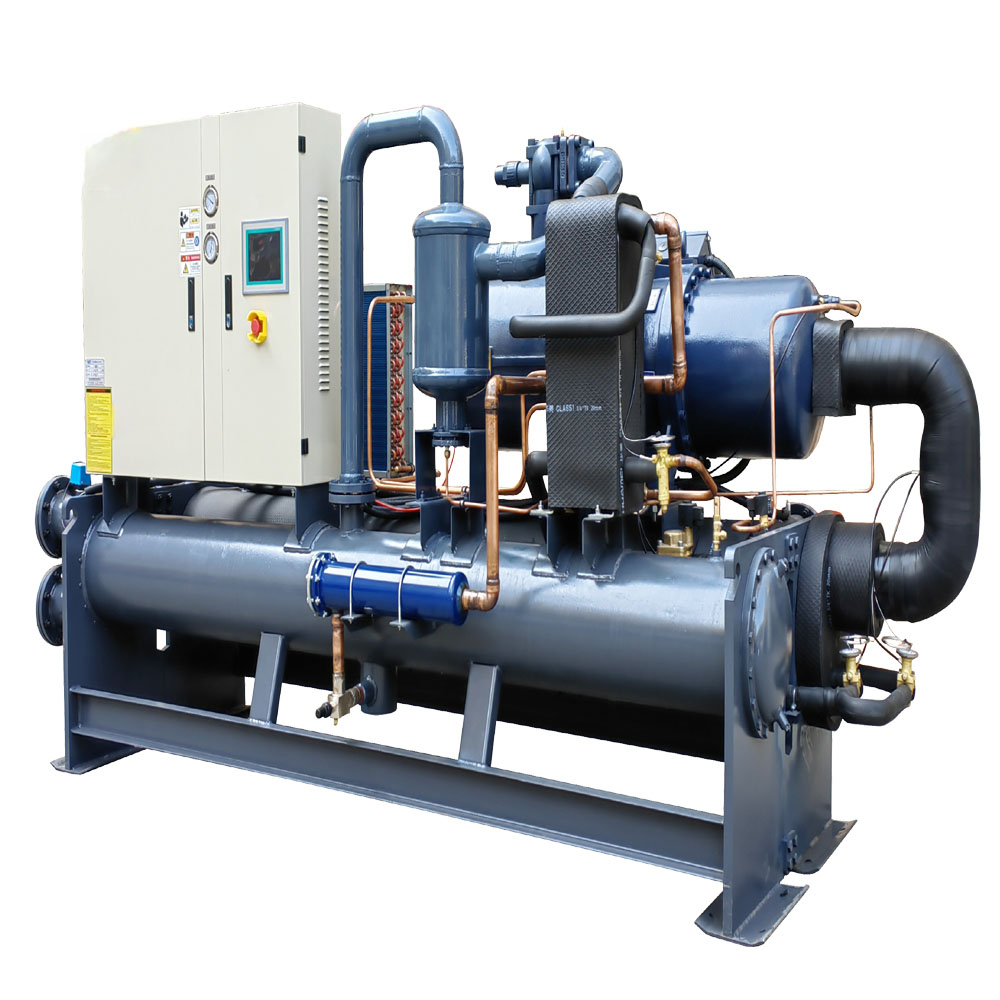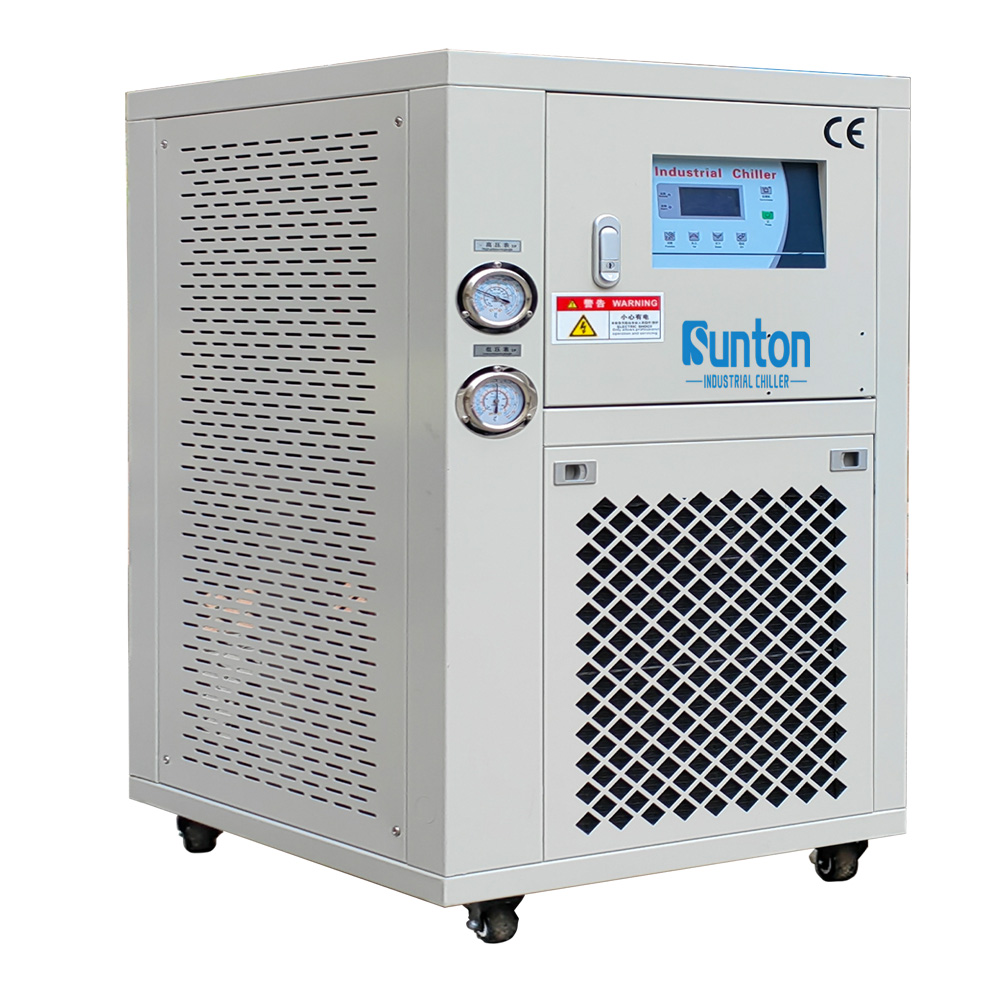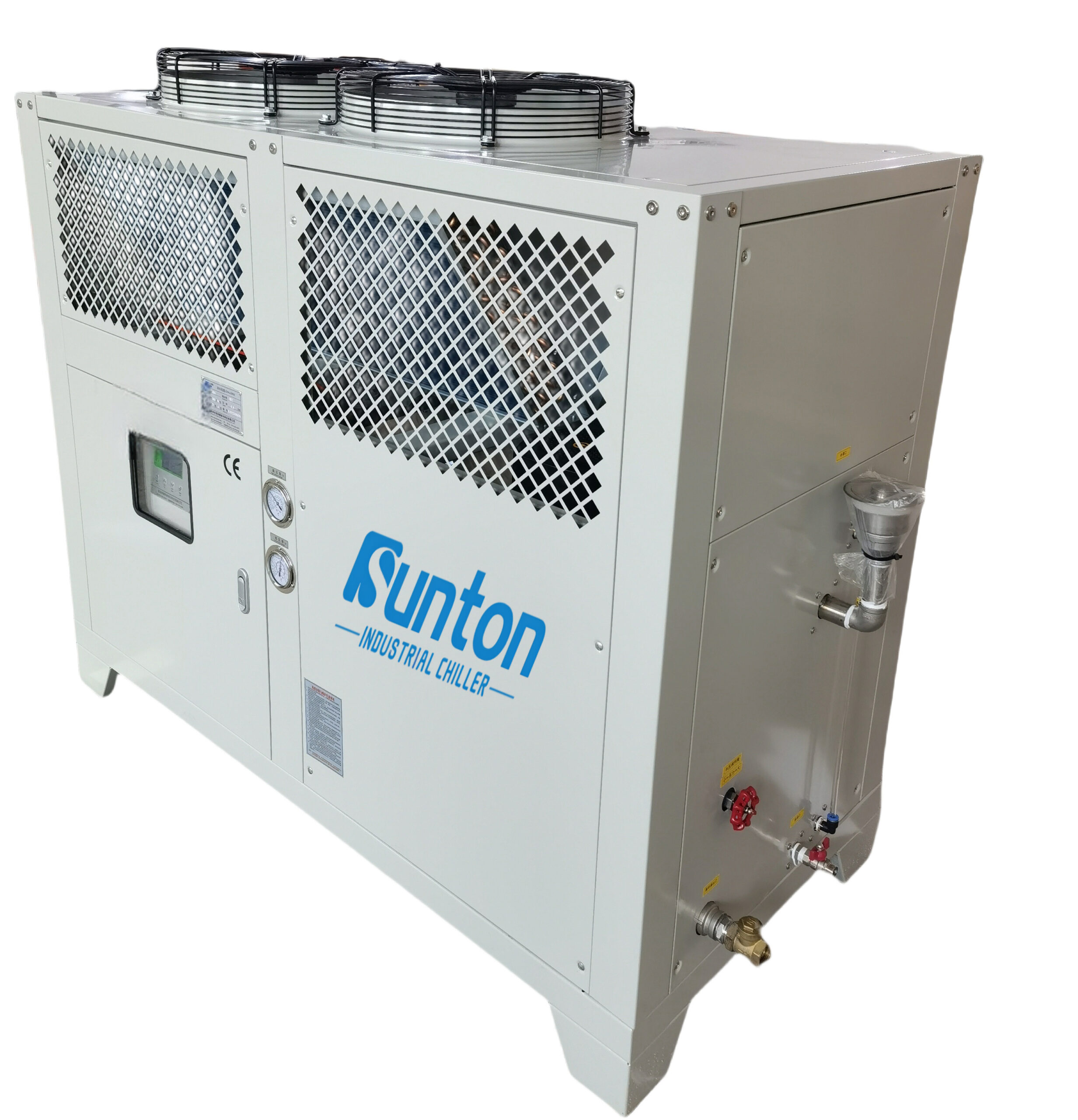-
Dalingshan Industrial Guangdong
Cara Memilih Pendingin Anodisasi
Panduan Utama untuk Anodizing Chillers: Memastikan Presisi dan Kualitas dalam Proses Finishing Logam Anda
Apakah Anda terlibat dalam finishing logam, anodizing, atau plating? Maka Anda tahu betapa pentingnya kontrol suhu adalah untuk mencapai hasil yang konsisten dan berkualitas tinggi. Artikel ini membahas dunia pendingin anodisasi untuk pendinginan anodisasi sangat penting dalam menjaga stabilitas suhu yang dibutuhkan., mengeksplorasi pentingnya, fungsionalitas, dan bagaimana mereka dapat disesuaikan untuk kebutuhan spesifik Anda kebutuhan finishing logamKami akan memandu Anda melalui berbagai jenis pendingin tersedia, membantu Anda memahami ideal solusi pendinginan untuk proses industri Anda dan menunjukkan kepada Anda cara mendapatkan hasil terbaik dengan pendingin anodisasi berpendingin air kami yang penting untuk mempertahankan suhu optimal. pendingin anodisasi untuk proyek Anda.
Daftar Isi
Artikel terperinci tentang pendingin pelapisan anodisasi industri untuk penyelesaian logam:
1. Mengapa sebuah Pendingin Penting untuk Proses Anodisasi?
The proses anodisasi, sebuah langkah penting dalam banyak hal proses penyelesaian logam, melibatkan pembuatan lapisan oksida pelindung pada permukaan bagian logam melalui proses elektrolitik. Proses ini menghasilkan panas yang signifikan, dan tanpa proses yang tepat sistem pendingin, yang suhu proses anodisasi dapat dengan mudah naik tak terkendali. Panas tak terkendali ini akan menyebabkan ketidakkonsistenan dalam lapisan, sehingga menghasilkan hasil akhir yang tidak rata, berkualitas rendah, dan bahkan dapat menyebabkan kegagalan fungsi peralatan. Pendingin bukan hanya sekedar aksesoris, namun merupakan persyaratan mendasar untuk menjaga ketepatan kontrol suhu diperlukan untuk superior lapisan logamEfisiensi dan stabilitas pendingin sangat penting untuk konsistensi pelapisan logam, yang menentukan kualitas dan ketahanan produk akhir. Singkatnya, mereka adalah landasan pendingin industri yang efektif untuk pendinginan anodisasi. anodisasi untuk sebuah industri finishing permukaan.
Tanpa benar pendinginan anodisasi, bahan kimia dalam bejana anodisasi dapat menjadi tidak stabil, sehingga menyebabkan daya rekat yang buruk lapisanHal ini tidak hanya mengurangi kualitas produk akhir, tetapi juga menambah potensi pemborosan material dan peningkatan waktu dan biaya produksi. pendingin mempertahankan kisaran suhu optimal, memastikan bahwa setiap bagian mengalami proses anodisasi dalam kondisi ideal. Hal ini menghasilkan kualitas yang konsisten, mengurangi kemungkinan cacat, dan juga menghemat uang dengan meminimalkan pemborosan. Sebagai produsen yang berpengalaman, saya memahami nuansa pendinginan anodisasi dan telah mengembangkan yang dapat diandalkan Lini pendingin anodisasi mencakup model canggih yang dirancang khusus untuk pelapisan dan anodisasi. untuk memenuhi tuntutan spesifik Anda.
2. Bagaimana Cara Kerja Pendingin Anodisasi Bekerja di Proses Pelapisan?
Ketika anodisasi adalah proses elektrokimia khusus untuk aluminium, pelapisan adalah istilah yang lebih luas yang mencakup penerapan berbagai logam pelapis ke substrat yang berbeda. Keduanya proses anodisasi dan pelapisan menghasilkan panas, dan keduanya mendapat manfaat besar dari penggunaan pendingin. Pelapisan proses seperti pelapisan nikel dan pelapisan krom juga butuh ketepatan kontrol suhu untuk adhesi logam yang tepat ke substrat dan untuk memastikan pengendapan logam yang seragam dan konsisten. pendingin anodisasi bukan hanya untuk anodisasi; kemampuannya meluas ke mana saja proses industri yang membutuhkan ketelitian kontrol suhu.
Di sebuah proses pelapisan, yang pendingin memastikan bahwa pelapisan larutan dipertahankan pada suhu yang tepat, yang secara langsung mempengaruhi kualitas pelapisan logamApakah itu proses pelapisan seng atau jenis lainnya pelapisan logam, efisien pendingin meningkatkan proses dengan menjaga larutan pada suhu yang dibutuhkan selama proses pelapisan. Sesuai pendinginan menghasilkan ketebalan lapisan yang seragam dan mengurangi pembentukan produk sampingan yang tidak diinginkan. Konsistensi ini penting untuk ketahanan produk dan juga mengurangi pengerjaan ulang dan pemborosan bahan.
3. Apa Kuncinya Fitur Pendingin Anodisasi?
Berkualitas tinggi pendingin anodisasi lebih dari sekedar alat pendingin; ini adalah peralatan canggih yang dirancang untuk memenuhi tuntutan proses industri kondisi. Fitur utama harus mencakup konstruksi yang kuat dan tahan korosi, efisiensi energi yang tinggi, dan akurat kontrol suhuCarilah model yang memiliki antarmuka yang mudah digunakan, mekanisme keamanan yang andal, dan kemampuan untuk berkomunikasi dengan bagian lain dari lini produksi Anda. pendingin diproduksi dengan komponen berkualitas tinggi untuk memastikan keandalan jangka panjang dan perawatan minimal, memastikan Anda memiliki sistem pendingin industri terbaik di kelasnya.
Salah satu aspek penting adalah bahan yang digunakan dalam pendinginBerkualitas tinggi pendingin harus memiliki komponen yang dibuat untuk menahan korosi dari bahan kimia yang digunakan dalam proses anodisasi dan pelapisanIni termasuk penggunaan bahan-bahan seperti baja tahan karat atau pelapis khusus yang mencegah kerusakan. Selain itu, pendingin anodisasi dilengkapi dengan panel kontrol digital yang menawarkan kemudahan penggunaan dan memungkinkan operator untuk menyesuaikan titik setel. pendingin membantu menjaga lini produksi Anda berjalan lancar, dan meningkatkan daya tahan dan umur panjang peralatan, sekaligus menghemat biaya energi.
4. Bagaimana caranya Didinginkan dengan Air dan berpendingin udara Pendingin Berbeda untuk Penyelesaian Logam?
Ketika mempertimbangkan pendingin Untukmu penyelesaian logam operasi, salah satu keputusan penting adalah memilih antara didinginkan dengan air dan model berpendingin udara. Pendingin berpendingin air menggunakan yang terpisah sistem pendingin air untuk menghilangkan panas, sehingga membuatnya sangat efisien, terutama di fasilitas besar dan lingkungan industri di mana sejumlah besar panas dari anodisasi diproduksi. Unit ini sering kali lebih senyap daripada unit berpendingin udara dan cocok untuk lingkungan yang tingkat kebisingannya menjadi perhatian utama, tetapi memerlukan sumber air pendingin, yang terkadang memerlukan perawatan lebih banyak dan biaya awal yang lebih tinggi.
Di sisi lain, pendingin udara pendingin menggunakan kipas untuk menghilangkan panas, sehingga lebih mudah dipasang dan dirawat, dengan biaya awal yang lebih rendah dibandingkan dengan pendingin plating tradisional. Cocok untuk fasilitas atau lingkungan yang lebih kecil di mana akses air mungkin terbatas. Namun, mungkin kurang hemat energi dan menghasilkan lebih banyak kebisingan dibandingkan dengan didinginkan dengan air unit. Memilih antara pendingin udara atau air sangat bergantung pada kebutuhan fasilitas Anda, ruang yang tersedia, anggaran Anda, dan persyaratan khusus Anda anodisasi atau pelapisan operasi.
5. Apa Kapasitas Pendinginan Apakah Saya Membutuhkannya untuk Saya? Anodisasi dan Pelapisan Aplikasi?
Menentukan yang benar kapasitas pendinginan sangat penting bagi efisiensi dan efektivitas Anda pendingin anodisasiYang dibutuhkan kapasitas pendinginan anodizing tergantung pada beberapa faktor, termasuk ukuran bejana anodisasi, volume elektrolit, jenis proses anodisasi, suhu lingkungan, dan durasi proses pelapisan. Ukuran yang terlalu kecil pendingin tidak akan memberikan pendinginan yang cukup untuk mempertahankan suhu ideal, sementara yang berukuran besar pendingin dapat menyebabkan konsumsi energi dan biaya yang tidak perlu. Misalnya, anodisasi titanium proses mungkin memerlukan kapasitas yang berbeda dari anodisasi asam kromat aplikasi.
Untuk menentukan secara akurat kapasitas pendinginan kebutuhan, disarankan untuk melakukan perhitungan beban panas secara rinci dari seluruh proses Anda. Perhitungan ini akan memperhitungkan panas yang dihasilkan selama proses anodisasi, panas yang dihasilkan oleh komponen listrik dalam sistem Anda, dan faktor lingkungan lainnya. Berdasarkan hal ini, Anda dapat memilih pendingin dengan yang sesuai kapasitas pendinginan, biasanya diukur dalam ton atau BTU. Sebaiknya konsultasikan dengan profesional pendingin pemasok, yang dapat membantu Anda menghitung beban pendinginan dan memilih yang sesuai pendingin untuk kebutuhan unik Anda.
6. Apa Jenis Anodisasi Apakah Anda Menggunakannya, dan Bagaimana Pengaruhnya Pendingin Pilihan?
The jenis anodisasi Anda melakukan akan berdampak signifikan pada pendingin Persyaratan. Berbeda jenis anodisasi menyukai anodisasi lapisan keras tipe 3, Anodisasi kromat merupakan salah satu aplikasi utama dari pendingin anodisasi., dan yang lainnya memiliki persyaratan suhu yang berbeda. Misalnya, anodisasi lapisan keras tipe 3 biasanya memerlukan suhu yang lebih rendah untuk menghasilkan produk yang lebih tebal dan lebih tahan lama lapisan dibandingkan anodisasi komersialMemahami persyaratan suhu yang tepat dari proses anodisasi sangat penting untuk memilih yang tepat pendinginKetidaksesuaian suhu dapat menyebabkan kualitas lapisan kualitas dan kinerja yang menurun.
Berbeda proses anodisasi menghasilkan jumlah panas yang berbeda-beda, yang pada gilirannya akan memengaruhi pendingin pilihan. Misalnya, anodisasi lapisan keras tipe 3 biasanya membutuhkan lebih besar kapasitas pendinginan karena kepadatan arusnya yang lebih tinggi dan suhu pengoperasian yang lebih rendah dibandingkan jenis lainnya. Sebelum memilih pendingin, pertimbangkan persyaratan khusus untuk proses Anda. Saya dapat membantu menganalisis kebutuhan spesifik Anda anodisasi aplikasi untuk memastikan Anda mendapatkan pendingin yang sesuai dengan kebutuhan spesifik Anda kebutuhan pendingin dan anodisasi chiller secara efektif.
7. Bagaimana Anda Menentukan Waktu yang Benar? Pendingin Anodisasi untuk Aplikasi Anda?
Memilih yang tepat pendingin anodisasi untuk aplikasi Anda Memilih chiller yang tepat untuk pendinginan anodizing bisa menjadi keputusan yang menantang, tetapi perlu. Langkah pertama melibatkan evaluasi spesifik Anda pendinginan kebutuhan, termasuk volume elektrolit, luas permukaan bagian yang Anda anodisasi atau pelapisan, suhu pengoperasian, dan total waktu pengoperasian. Anda juga harus mempertimbangkan suhu sekitar lingkungan kerja Anda. Saya sarankan untuk mengomunikasikan semua persyaratan Anda sebelum pendingin pembelian. Sebuah teliti komunikasi kebutuhan pendingin akan membantu Anda menghindari masalah di masa mendatang.
Selanjutnya, pertimbangkan desain dan konstruksi pendingin. Konstruksi yang kokoh dengan komponen berkualitas tinggi akan memastikan keandalan dan keawetan. Pertimbangkan juga efisiensi energi unit untuk membantu mengurangi biaya pengoperasian jangka panjang. Terakhir, konsultasikan dengan pemasok berpengalaman yang menawarkan berbagai lini pendingin anodisasi untuk memberi Anda solusi yang disesuaikan untuk memastikan Anda proses penyelesaian logam beroperasi seefisien mungkin. Dengan saya pengalaman yang kaya dalam membuat anodisasi pendinginSaya bisa memberi Anda penjelasan rinci analisis solusi pendingin dan memberi Anda solusi pendingin penyelesaian logam yang tepat untuk kebutuhan Anda.
8. Apa saja perbedaan Jenis-jenis Pendingin Anodisasi Tersedia?
Ada berbagai macam jenis-jenis chiller anodizing dirancang untuk memenuhi berbagai kebutuhan dan pengaturan industri. Umumnya, ini dapat dikategorikan berdasarkan metode pendinginan, kapasitas, dan fitur. Jenis yang umum termasuk pendingin anodisasi berpendingin air unit, dan sistem berpendingin udara. Kedua jenis ini tersedia dalam berbagai ukuran dan kapasitas, mulai dari unit portabel kecil hingga sistem sentral besar. Beberapa pendingin juga dilengkapi dengan fitur-fitur khusus, seperti sistem pompa dan tangki terintegrasi. Saya dapat menyediakan sistem tangki pompa khusus disesuaikan dengan kebutuhan spesifik Anda.
Selain itu, beberapa pendingin dirancang untuk lingkungan atau proses tertentu, seperti pendingin anti ledakan untuk lokasi berbahaya, dan unit presisi untuk aplikasi yang membutuhkan stabilitas suhu yang sangat akurat. Pilihan pendingin jenis harus sesuai dengan Anda anodisasi atau pelapisan proses, infrastruktur fasilitas Anda, dan anggaran Anda. Memahami perbedaannya jenis-jenis chiller anodizing tersedia membantu Anda dalam membuat pembelian yang tepat yang meningkatkan kemampuan manufaktur Anda.
9. Mengapa Memilih Kami Sebagai Mitra Anda? Produsen dan Pemasok Pendingin Anodisasi?
Memilih yang tepat produsen dan pemasok pendingin anodisasi sama pentingnya dengan memilih yang tepat pendinginSebagai produsen terkemuka anodizingSaya tidak hanya menyediakan kualitas tinggi pendingin tetapi juga menawarkan dukungan teknis dan layanan kustomisasi yang luas. Pengalaman kami yang lama dalam industri finishing permukaan dan pemahaman mendalam kita tentang proses anodisasi dan pelapisan memastikan bahwa produk kami efisien dan dapat diandalkan. Tim saya berkomitmen untuk bermitra dengan Anda, memberikan layanan yang luar biasa, dan memastikan kepuasan Anda sepenuhnya. Saya adalah produsen terkemuka dengan dedikasi terhadap kualitas dan inovasi.
Kami tidak hanya mengkhususkan diri dalam pembuatan dan pemasangan solusi pendinginan terbaik untuk bisnis Anda, tetapi juga menawarkan konsultasi desain lengkap, instalasi, dan dukungan pemeliharaan berkelanjutan. Kami memahami beragam kebutuhan industri finishing, dan menawarkan berbagai macam peralatan pendingindan sistem tangki pompa khusus yang dapat dilengkapi untuk menangani semua anodisasi dan pelapisan aplikasi. Anda dapat mengandalkan saya sebagai mitra, saya dapat memberi Anda pendingin anodizing ekonomis yang cocok sesuai dengan anggaran Anda, dan saya memiliki pengetahuan untuk membantu Anda memilih yang tepat pendingin yang sesuai dengan kebutuhan anda.
10. Bisakah Kamu Sesuaikan Pendingin Anodisasi Anda?
Ya, tentu saja. Salah satu keuntungan utama bermitra dengan kami adalah kemampuan kami untuk Sesuaikan pendingin anodisasi Anda untuk memenuhi kebutuhan unik Anda. Kami memahami bahwa setiap proses penyelesaian logam berbeda, dan solusi siap pakai mungkin tidak selalu optimal. Apakah Anda memerlukan solusi khusus kapasitas pendinginan, desain unik, bahan khusus, atau fitur kontrol khusus, kami dapat menyesuaikannya pendingin untuk aplikasi spesifik Anda. Kami menawarkan fleksibilitas dalam desain pendingin, yang mencakup berbagai ukuran, konfigurasi, dan fitur khusus, semuanya dirancang untuk memenuhi kebutuhan spesifik Anda, dan membantu menyederhanakan proses produksi Anda.
Tim teknisi kami yang berpengalaman akan bekerja sama dengan Anda untuk memahami kebutuhan finishing logam dan merancang sebuah sistem pendingin yang terintegrasi dengan peralatan Anda yang sudah ada. Tujuan kami adalah menawarkan solusi yang efisien dan hemat biaya. Dari konsultasi awal hingga instalasi akhir, kami berkomitmen untuk menyediakan solusi yang sesuai dengan kebutuhan Anda. pendingin yang memaksimalkan produktivitas bisnis Anda. Dengan menyesuaikan pendingin, kami bertujuan untuk mengoptimalkan kinerja secara keseluruhan dan membantu Anda mencapai hasil terbaik setiap saat. Kami membantu Anda mendapatkan hasil maksimal dari uang Anda.
<center> <img src="”https://placekitten.com/400/300″" alt=""A" cute kitten.”> </center>
Pertanyaan Umum
Berapa kisaran suhu ideal untuk anodisasi?
Kisaran suhu ideal untuk anodisasi biasanya berkisar antara 60-75 derajat Fahrenheit, tergantung pada jenisnya jenis anodisasi sedang dilakukan. Mempertahankan suhu yang konsisten sangat penting untuk memastikan ketebalan dan kualitas lapisan yang seragam.
Seberapa seringkah seharusnya pendingin dilayani?
Perawatan rutin sangat penting untuk kinerja yang optimal. pendingin secara umum harus diperiksa dan diservis setidaknya setahun sekali, atau lebih sering tergantung pada penggunaan dan kondisi lingkungan. Ini termasuk memeriksa level refrigeran, membersihkan kumparan, dan memverifikasi semua sambungan listrik.
Bisakah sebuah pendingin bisa digunakan untuk keduanya anodisasi dan pelapisan?
Ya, banyak pendingin dirancang untuk menyediakan pendinginan untuk berbagai proses, termasuk keduanya anodisasi dan pelapisanNamun, penting untuk memilih pendingin yang dapat menangani persyaratan suhu dan kapasitas spesifik untuk setiap proses.
Bagaimana saya tahu jika saya pendingin tidak bekerja dengan benar?
Tanda-tanda kerusakan pendingin dapat mencakup kontrol suhu yang tidak konsisten, suara yang tidak biasa, kapasitas pendinginan yang berkurang, dan pesan kesalahan pada panel kontrol. Jika Anda melihat salah satu masalah ini, penting untuk segera menghubungi pendingin diperiksa oleh teknisi yang berkualifikasi.
Apakah ada ukuran standar? pendingin untuk anodisasi?
Tidak, ukurannya pendingin dibutuhkan untuk anodisasi sangat bervariasi tergantung pada skala operasi. Pendingin berkisar dari unit portabel kecil hingga sistem industri besar. Ukuran yang benar ditentukan oleh beban panas proses anodisasi, ukuran dari bejana anodisasi, dan kondisi sekitar.
Apakah Anda memberikan pelatihan tentang cara mengoperasikan pendingin?
Ya, kami menawarkan pelatihan komprehensif tentang cara mengoperasikan dan memelihara pendingin secara efektif, memastikan bahwa tim Anda sepenuhnya diperlengkapi untuk mengelola peralatan baru Anda sejak hari pertama. Pelatihan kami dirancang agar mudah dipahami, sehingga operator baru dan berpengalaman dapat menggunakan pendingin secara efisien.
Poin-poin Utama:
- Kontrol Suhu: Tepat kontrol suhu sangat penting untuk kualitas tinggi proses penyelesaian logam, termasuk anodisasi dan pelapisan.
- Pentingnya Pendingin: Sebuah pendingin anodisasi penting untuk menjaga suhu optimal, memastikan konsistensi lapisan kualitas dan mengurangi cacat, serta meningkatkan produksi dan efisiensi dengan fitur anodizing chiller kami.
- Pemilihan Pendingin: Memilih yang tepat pendingin membutuhkan pertimbangan cermat terhadap faktor-faktor seperti kapasitas pendinginan, jenis anodisasi, dan kebutuhan fasilitas, Anda mungkin perlu pendingin udara atau air.
- Kustomisasi: Pendingin dapat disesuaikan untuk memenuhi persyaratan tertentu, memastikan kinerja optimal dan integrasi ke dalam lini produksi yang ada.
- Pilihan Produsen: Bermitra dengan perusahaan yang memiliki reputasi baik produsen dan pemasok pendingin anodisasi sangat penting untuk mendapatkan peralatan yang andal dan dukungan teknis untuk Anda sistem pendingin industri.
- Keserbagunaan: Pendingin adalah peralatan serbaguna, cocok untuk berbagai keperluan pendinginan proses industri aplikasi, tidak hanya anodisasi, tetapi untuk proses apa pun yang membutuhkan kontrol suhu dan peralatan pendingin proses seperti sistem pelapisan dan pelapisan logam.
- Pemeliharaan:Pemeliharaan rutin dan berkelanjutan sangat penting untuk memastikan umur panjang dan efisiensi mesin Anda. peralatan pendingin.
Kami memproduksi dan memasang solusi pendinginan terbaikHubungi kami hari ini untuk mendiskusikan bagaimana pendingin dapat meningkatkan Anda proses penyelesaian logamBiarkan saya membantu Anda dengan pendingin industri yang tepat untuk kebutuhan finishing logam Anda. solusi pendinginan untuk logam AndaBersama-sama, kita bisa menemukan yang terbaik solusi untuk finishing logam AndaTemukan manfaat pendingin pelapisan dan anodisasi kami hari ini.
Tautan Internal:
- Pelajari lebih lanjut tentang keberagaman kami lini peralatan pendingin: Pendingin glikol untuk aplikasi finishing logam.
- Jelajahi berbagai produk kami didinginkan dengan air Solusi: Pendingin Air Gulir Berpendingin Air
- Temukan bagaimana kami dapat menyesuaikan sistem pendingin untukmu: Pendingin Anti-Ledakan
- Lihat solusi kami untuk kebutuhan pendinginan sentral: Pendingin Sentral Sekrup Berpendingin Udara
- Jelajahi pusat kami sistem pendingin air: Pendingin Sentral Sekrup Berpendingin Air
- Baca tentang berbagai jenis pendingin sekrup kami: Pendingin Sekrup Berpendingin Udara

